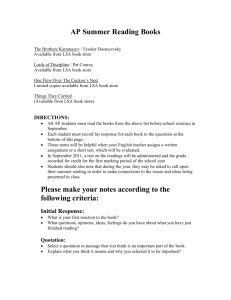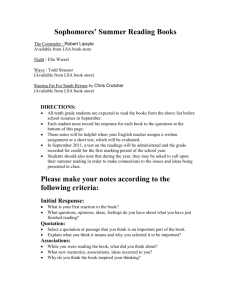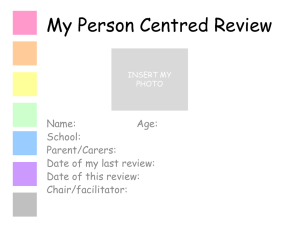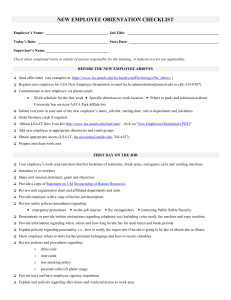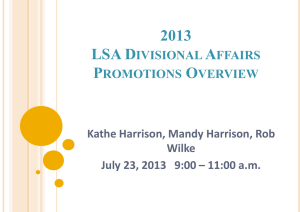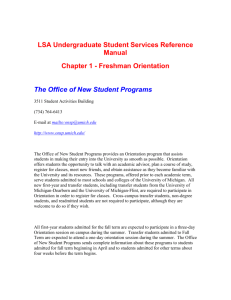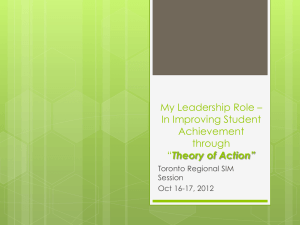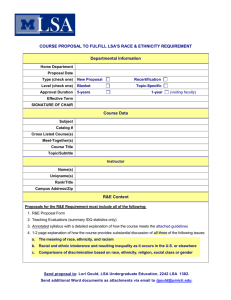Appendix C*=***&
advertisement
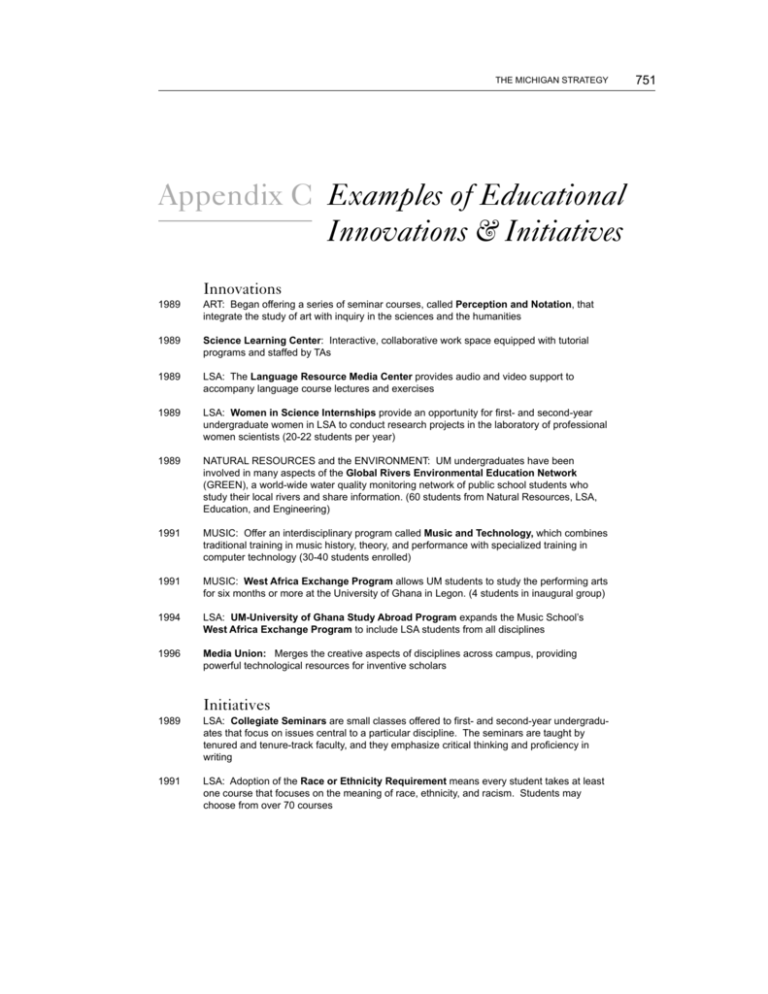
THE MICHIGAN STRATEGY Appendix C Examples of Educational Innovations & Initiatives Innovations 1989 ART: Began offering a series of seminar courses, called Perception and Notation, that integrate the study of art with inquiry in the sciences and the humanities 1989 Science Learning Center: Interactive, collaborative work space equipped with tutorial programs and staffed by TAs 1989 LSA: The Language Resource Media Center provides audio and video support to accompany language course lectures and exercises 1989 LSA: Women in Science Internships provide an opportunity for first- and second-year undergraduate women in LSA to conduct research projects in the laboratory of professional women scientists (20-22 students per year) 1989 NATURAL RESOURCES and the ENVIRONMENT: UM undergraduates have been involved in many aspects of the Global Rivers Environmental Education Network (GREEN), a world-wide water quality monitoring network of public school students who study their local rivers and share information. (60 students from Natural Resources, LSA, Education, and Engineering) 1991 MUSIC: Offer an interdisciplinary program called Music and Technology, which combines traditional training in music history, theory, and performance with specialized training in computer technology (30-40 students enrolled) 1991 MUSIC: West Africa Exchange Program allows UM students to study the performing arts for six months or more at the University of Ghana in Legon. (4 students in inaugural group) 1994 LSA: UM-University of Ghana Study Abroad Program expands the Music School’s West Africa Exchange Program to include LSA students from all disciplines 1996 Media Union: Merges the creative aspects of disciplines across campus, providing powerful technological resources for inventive scholars 1989 LSA: Collegiate Seminars are small classes offered to first- and second-year undergraduates that focus on issues central to a particular discipline. The seminars are taught by tenured and tenure-track faculty, and they emphasize critical thinking and proficiency in writing 1991 LSA: Adoption of the Race or Ethnicity Requirement means every student takes at least one course that focuses on the meaning of race, ethnicity, and racism. Students may choose from over 70 courses Initiatives 751 752 APPENDIX C 1992 LSA: Theme Semesters (e.g. Comedy, Beyond 1492, Work, Evil) Students take a number of courses, offered by different departments, that are organized around a unifying theme. The purpose is to develop courses that each provide a different perspective on one theme and that also meet the general distribution requirement 1992 ENGINEERING: LeaderShape 1993 LSA: CUE Courses These new distribution courses for first- and second-year students are designed intentionally around a topic that emphasizes linkages between disciplines 1994 LSA: Writing portfolios required of all students for placement in English courses 1994 LSA: New First-year Seminars are small enrollment courses taught largely by regular and emeritus faculty 1994 LSA: Quantitative Reasoning Requirement that requires students to take one course that exposes them to the process of examining quantitative evidence and of drawing conclusions based on that evidence. These courses are offered by departments such as Chemistry, Communications, Economics, Mathematics, Philosophy, Physics, Political Science, Sociology, and Statistics 1989 LSA: Reform of Chemistry 210-211, the introductory chemistry sequence for students with good high school preparation, to emphasize the process of doing chemistry, rather than solving mathematical problems and memorizing formulas or definitions (2000 students per year) 1992 LSA: Reform of Math 115-116, which is the introductory calculus sequence, so that it emphasizes mathematical reasoning rather than computational maniupulation, and it uses imaginative new teaching materials and methods (4000 students per year) 1992 LSA: Revision of teaching assignments and curriculum in Geology, resulting in the development of a large number of seminar courses, taught by tenure-track faculty, for firstand second-year students, especially those who do not plan to major in the sciences 1993 LSA: Offering new B.A. degree in General Biology. It is intended for students with interests in the sciences, but who do not intend to become practicing biologists 1993 LSA: Reform of Chemistry 125-130, the standard introductory sequence for students whose high school backgrounds do not qualify them for enrollment in Chemistry 210-211. The course sequence emphasizes learning through collaborative discovery (4000 students per year) 1993 LSA: Offering new B.A. or B.S. degree in General Physics for students who want a strong background in science but want to pursue a broader general education or pursue a double major 1993 Reorganization of the Inteflex Program, a program run jointly by LSA and the Medical School since 1972, to identify and prepare minority students and to provide a vehicle for curricular innovation in premedical education 1994 ENGINEERING: Interative computer modeling to teach thermodynamics Curriculum Reforms THE MICHIGAN STRATEGY 1994 LSA: Reform of Physics 127-128 and 141-241, the lab courses that accompany the two introductory sequences in physics (4000 students per year) 1994 LSA: New B.S. degree offered in Biochemistry, which was developed cooperatively by the Departments of Biology, Chemistry, and Biological Chemistry to respond to undergraduate interest in this field 1994 LSA: Offering new B.A. degree in Classical Civilization for students with an interest in ancient civilizations, but who are not trained in Latin and Greek 1990 Language requirement strengthened from simply completing four semesters of course work to demonstrating a level of proficiency 1992 Reformulation of a set of middle- and upper-level language courses to focus on substantive topics learned through a second language, rather than on second-language learning per se 1993 Participation of and cooperation between LSA and Engineering in the new Engineering Global Leadership Honors Program (LSA provides the “Cultural Core”) 1993 Approval of tenure-track positions that would be evaluated on the basis of pedagogy and pedagogical research rather than more traditional literary research 1993 Change in the Directorship of the Office of International Programs (OIP) from a half-time to a full-time position and incorporation of the OIP into the new International Institute in an effort to forge stronger links between area study research and student study abroad 1994 Creation of special section in large lecture courses, taught by non-language departments, in which teaching materials and discussion will be in a foreign language Pedagogy 1987 Thurnau Professorships recognize tenured faculty whose contributions to undergraduate education have had demonstrable impact on the intellectual development and, indeed, the very lives of our students. 1988 LSA: Collegiate Fellows Program, which brings senior faculty together to talk about teaching and to work on revising courses so they emphasize critical thinking 1988 LSA: Implementation of the TA Training Program, which provides an intensive orientation followed by six weekly sessions to prepare graduate students for their role as a teaching assistant. The program includes practical information on instructional methods, and increases sensitivity to discrimination in the classroom and the development of a more multicultural approach to teaching 1989 ENGINEERING: TA Training 1990 LSA: Revision of teaching assignments in English, resulting in a doubling of the number of 100- and 200-level courses taught by tenure-track faculty 1991 ENGINEERING: Teaching Awards 1991 ENGINEERING: Faculty Fellows Program (teaching methods) 1991 LSA: Excellence in Education Awards provide financial rewards to faculty to recognize the importance of their contributions to teaching and related activities 753 754 APPENDIX C 1992 Orientation Program for New Faculty, which emphasizes the value placed on effective teaching 1993 LSA: More rigorous testing and training programs for International TAs 1993 Program of mid-term visitations and evaluations of classes initiated with the assistance of the Center for Research on Learning and Teaching (CRLT) 1993 LSA: Appointment of a tenure-track faculty member interested in mathematical pedagogy to direct the Math Lab, a facility to provide out-of-class assistance for students in introductory math courses 1993 LSA: Master Teaching Program in Physics, which brings in an outstanding teacher for two terms to review the undergraduate curriculum and suggest improvements 1988 Intergroup Relations and Conflict is a multifaceted approach to increasing multicultural understanding among students of different groups through courses and dialogue groups (250 take introductory course; 550 participated in dialogue groups) 1988 LSA: Undergraduate Research Opportunity Program (UROP) allows first- and secondyear students to conduct research in collaboration with a member of the University faculty (supported 7 students) 1988 Placement of academic advisors in residence halls 1989 NATURAL RESOURCES and the ENVIRONMENT: Natural Resources Mentoring Program. Graduate students meet regularly with first- and second-year undergraduates to discuss issues of mutual concern and participate in a weekly seminar introducing students to the broad field of natural resources (30 students) 1989 LSA: Science Learning Center provides support for science education at introductory and advanced levels through forums for discussion, a library of instructional materials, and assistance for pedagogical innovation 1991 NURSING: The Nursing Health Information Center provides nursing students with valuable clinical experience while helping the multicultural community of UM’s North Campus (30 students per year) 1991 NURSING: Nursing Research Experience provides undergraduate nursing students with opportunities to collaborate on research projects with nursing faculty (70 students-required of juniors) 1991 LSA: Major expansion of UROP to support over 500 students 1991 Mentoring Program to help build a sense of belonging to the UM community, to help firstyear students with their transition to adulthood, and to assist first-year students in understanding and achieving their educational goals 1991 Implementation of the 21st Century Program, which is a living-learning experiment combining seminars on college issues and “subject mastery workshops” held within the supportive community of the residence hall (267 students in first year of program) 1991 ENGINEERING: Solar Car Team THE MICHIGAN STRATEGY 1991 ENGINEERING: Advisory Office for Women in Engineering 1991 ENGINEERING: Pipeline Program (Parker Scholars Program) provides support services and research opportunities to third-year undergraduate women in engineering (60 students) 1993 Creation of Women in Science and Engineering (WISE) Residence Hall for first-year women interested in science or engineering 1993 Creation of Pilot Program Interest Corridors in residence halls (e.g. Films, Filmmaking and Drama/Creative Writing; Foreign Languages/International Politics) 1988 Undergraduate Initiatives Fund 1988 ENGINEERING: Engineering Commission on Undergraduate Education: An Agenda for Innovative Engineering 1990 LSA: Formation of the Planning Committee on Undergraduate Education (PCUE) 1990 LSA: Appointment of Assistant Dean for Undergraduate Curriculum 1991 ENGINEERING: Appointment of Associate Dean for Undergraduate Affairs 1991 LSA: Publication of “A Michigan Education,” the report of PCUE, which informed many of the recent changes 1992 ENGINEERING: Student Surveys on Undergraduate Educational Experience 1994 Task Force on the First Year Experience, which served as a catalyst for programmatic innovation 1994 Revitalization of the Center for Research on Learning and Teaching (CRLT) 755
